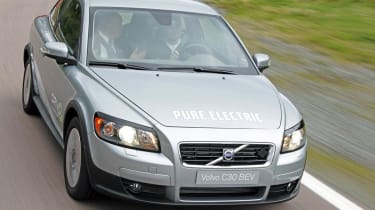Volvo C30 Electric
Swedish hatch set to join battery power revolution – and we try an early prototype.
Considering this C30 is an early prototype, its electric driveline bodes well for the production model – which will launch in Volvo’s next-generation hatch range. But the price could be an issue. Bosses believe it will cost £6,500 more than regular versions. If Government support is forthcoming and the company can improve this car’s range, it could make an interesting choice. Yet for realistic and affordable electric models, Renault is in pole position at the moment.
Here's the proof that Volvo is charging ahead with its electric car plans! The Swedish maker is hoping to enter the zero-emission, battery-powered vehicle market by 2012.
At first it will be with plug-in diesel-electric hybrids. But in February, it began work on a fully electric version of the C30 hatch. And bosses are so pleased with the results, they’ve allowed Auto Express to drive a prototype.
From the outside, the C30 BEV (Battery Electric Vehicle) looks identical to the low-emissions DRIVe version of the three-door. But under the bonnet, in place of an internal combustion engine, there is an electric motor and two lithium-ion battery packs.
The 100kg of extra weight that the batteries add currently sits over the front wheels, so this C30 feels nose heavy. But company engineers will address this for the production model by placing the cells under the car, in place of the fuel tank.
At the moment, there are no fancy Toyota Prius-style graphics on a screen in the cabin. Instead, a meter takes the space on the dash where the rev counter would normally be, and shows whether you’re using up charge – or if the barely perceptible regeneration system is replenishing the battery.
However, Volvo has managed to retain the rear seats in the design, and says a showroom version will do the same.
What’s really impressive, considering that this is such an early prototype, is how quiet it is. Battery-powered models are usually known for their milk float-style whine. But when you slot the regular automatic shift lever into ‘Drive’ and press the right pedal, the motor is near-silent. Engineers say even they are surprised at how removing the racket of a regular engine hasn’t uncovered a host of other noises from the C30.
The pace on tap impresses, too. As with other electric cars, all the torque is delivered at once, from zero revs, so the Volvo’s acceleration feels very strong, even up an incline. And with the equivalent of 110bhp (about the same as the regular DRIVe), it promises to sprint from 0-60mph in 10.5 seconds – that’s fractionally quicker than the current diesel car.
Exhaust emissions are zero, and the only downside is that the range is limited to 75-95 miles in normal driving conditions. But Volvo reckons that most buyers will be attracted to this car because the majority of their journeys are short commutes.
It also claims that charging the model fully from empty through a regular three-pin household socket will take eight hours. A shorter, two-and-a-half hour charge will give an extra 25 miles of driving. That’s not quite as good as Renault’s Z.E. models. But as a glimpse of Volvo’s electric future, the C30 is very impressive.
Rival: Renault Zoe Z.E.
Upcoming Clio-sized model gets a 95bhp electric motor giving a 100-mile range. Its battery takes less time to revive than the Volvo’s, too. Renault says it will cost no more than equivalent petrol or diesel cars.



